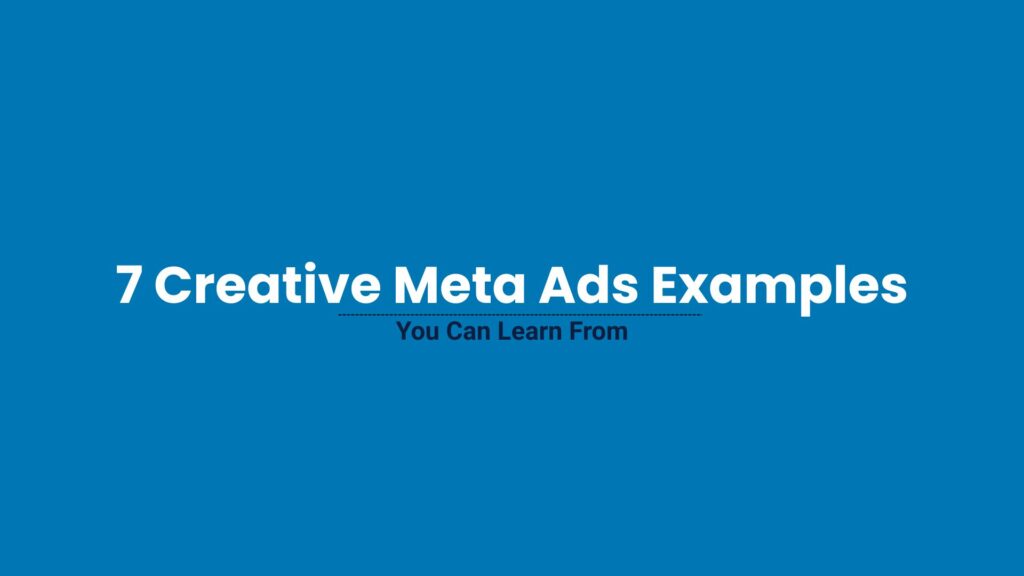
It was a typical afternoon scroll on Instagram. Nicole, a small business owner, was feeling overwhelmed. Her last few ad campaigns barely got clicks, and the few leads she managed to capture didn’t convert. She thought, “Maybe Meta Ads just aren’t for me.”
Then she saw it—a short video of a small sneaker brand telling a story about how their shoes were made sustainably, paired with a relatable, humorous caption. Within seconds, she felt engaged, inspired, and curious enough to click. That ad wasn’t flashy, it wasn’t overproduced, but it worked. It was creative, targeted, and resonated with her personally.
This is the power of creative Meta Ads. In a world where users scroll endlessly, only ads that connect emotionally, tell a story, or offer something genuinely interesting get noticed.
If you want your Meta Ads to perform better, it’s not enough to just “boost a post” or throw money at an audience. You need creativity, strategy, and lessons from brands that consistently get it right. Here are seven creative Meta Ads examples you can learn from, and how you can apply their strategies to your own campaigns.
Why Creativity Matters in Meta Ads
Meta Ads are everywhere. Every day, users scroll past hundreds of posts, stories, and reels. To break through the noise, your ad must:
- Grab attention instantly with visuals or videos.
- Speak directly to your audience with relatable copy.
- Deliver value quickly—users decide in seconds whether to engage.
- Encourage action, whether it’s clicking, sharing, or signing up.
Creativity isn’t just about aesthetics; it’s about understanding your audience, crafting a story, and giving them a reason to stop, watch, and act.
Example #1: Nike – Storytelling That Inspires
Nike’s Meta Ads have always been more than product promotions—they’re emotional journeys. One ad featured athletes overcoming challenges, highlighting their determination and resilience.
- Why it works: The story resonates emotionally, making viewers feel inspired and motivated.
- Lesson: Incorporate storytelling into your ads. Highlight journeys, challenges, or successes that resonate with your audience. Emotional ads are more likely to be shared and remembered.
Pro Tip: Even short videos can tell a powerful story if you focus on one clear emotional hook.
Example #2: Apple – Minimalism Speaks Louder Than Words
Apple’s Meta Ads are striking for their simplicity. One campaign displayed the latest iPhone against a clean background with minimal copy emphasizing its camera capabilities.
- Why it works: The clean, uncluttered design focuses attention on the product and its core benefit.
- Lesson: Don’t overcrowd your ads. Focus on one benefit or message that your audience can instantly understand.
Pro Tip: Pair minimal text with bold visuals to make a lasting impression.
Example #3: Airbnb – Authenticity Wins Hearts
Airbnb excels at using real experiences to promote its brand. Their “Live There” campaign featured photos of travelers staying in local homes, sharing stories of unique adventures.
- Why it works: Authentic, user-generated content builds trust and encourages engagement.
- Lesson: Incorporate real stories or experiences from your customers. Authenticity resonates more than polished, generic content.
Pro Tip: Encourage customers to share their stories and feature them in your ads—it’s relatable and cost-effective.
Example #4: Spotify – Humor & Relatability
Spotify’s campaigns are clever and playful. One campaign showcased funny playlist names based on user habits, making people smile and relate instantly.
- Why it works: Humor creates a memorable, shareable experience that people engage with.
- Lesson: Inject personality, humor, or relatability into your ads to capture attention.
Pro Tip: Know your audience well—humor only works if it resonates with their culture and interests.
Example #5: Coca-Cola – Interactive & Seasonal Ads
Coca-Cola’s “Share a Coke” campaign is a classic example of interactive Meta Ads. Personalized bottles with user names encouraged participation, while seasonal campaigns generated excitement around limited-edition designs.
- Why it works: Interactive campaigns make users feel part of the experience, boosting engagement.
- Lesson: Use interactive elements like quizzes, polls, or personalization to increase engagement and brand recall.
Pro Tip: Tie interactivity to a specific campaign goal like collecting emails or encouraging social shares.
Example #6: Grammarly – Problem-Solution Messaging
Grammarly’s ads focus on a common problem: writing mistakes. Their ads often show a “before-and-after” comparison, instantly communicating the product’s value.
- Why it works: Users immediately see the solution to a problem they care about.
- Lesson: Focus on solving a specific problem in your ads. Clear messaging converts better than generic brand promotion.
Pro Tip: Visual storytelling works best—show the problem and solution rather than just telling it.
Example #7: ASOS – Bold Visuals & Carousel Ads
ASOS uses vibrant visuals in carousel ads, allowing users to swipe through multiple products in one ad. Their campaigns often highlight trending items or limited-time offers.
- Why it works: The interactive carousel keeps users engaged longer and showcases more products in a single ad.
- Lesson: Experiment with formats. Carousel, video, and slideshow ads often outperform static single-image ads.
Pro Tip: Test the order of images in carousel ads—sometimes the first slide makes a huge difference in CTR.
Key Lessons From These 7 Ads
- Emotion drives engagement: Storytelling resonates more than just visuals.
- Simplicity wins: Focused, uncluttered messaging gets noticed faster.
- Authenticity builds trust: User-generated content and real stories perform better.
- Interactivity engages: Polls, quizzes, and personalization increase participation.
- Problem-solving sells: Ads that show solutions convert faster.
- Formats matter: Carousel, reels, and videos outperform static posts.
- Know your audience: Creativity only works when it aligns with audience needs and interests.
How to Apply These Lessons
- Study top-performing ads in your niche for inspiration.
- Test emotional storytelling and problem-solution approaches.
- Incorporate user-generated content or customer stories.
- Experiment with interactive features and different ad formats.
- Continuously analyze, test, and optimize your campaigns for better results.
Conclusion
Creative Meta Ads aren’t optional—they’re essential in today’s crowded digital landscape. Brands like Nike, Apple, Spotify, and ASOS demonstrate that creativity, emotion, and strategy can dramatically boost engagement and conversions.
By studying these examples and applying their lessons, you can create Meta Ads that don’t just get seen—they get remembered, shared, and acted upon. Start experimenting with storytelling, emotion, and interactivity today, and transform the performance of your campaigns.
